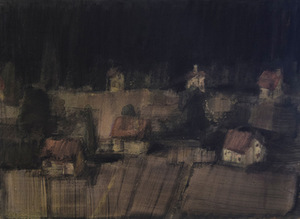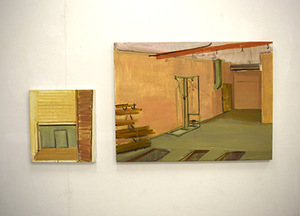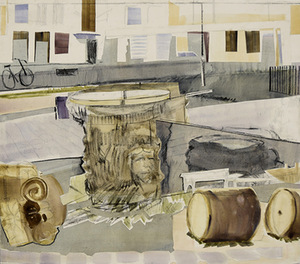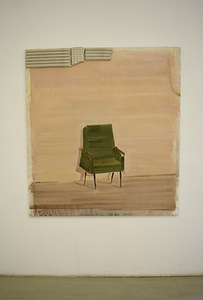Before Eglė Ulčickaitė was here 0
In brief: Young painter Eglė Ulčickaitė presents already a fourth solo exhibition "Temporary Places (before I was here)." The main theme of her works remains the same - the passage of time. This time, returning to the depiction of the Soviet times, Author (almost) leaves the characters behind and focuses on the atmosphere that they lived in, worked or spent their free time.
All the works by E. Ulčickaitė incite curiosity, a wish to see what author leaves outside the border of the canvas. Before I read the titles of paintings, written on the paper, lying down on the windowsill of the gallery, I imagened something completely different. In my mind, a man, who is stepping on the white fabric falling in vertical pleats, with his huge, black shoes, looks like a tyrant who is about to force a bride to the altar. Apparently, this is how Eglė depicts "the speech of the curator." I felt guilty because of all the art critics, curators and scholars...do artists really feel so oppressed?
However, leaving this rhetorical question aside, I would like to explore how the painter creates such influential scenes. First of all, she uses a fragmented composition principle invented by impressionists. Artist chops the limit of the painting where the object, most desired by the viewer should be. You can almost hear the gears rotating frantically in the viewer’s head, trying to focus the image and fill in the gaps. Secondly, E. Ulčickaitė, absolutely perfectly manages the format of canvases. It varies from 25 x 34 cm to 221 x 191 cm and each image is placed on just the right size for it. Placing large and small paintings close to each other creates a playful view, which makes the exhibition visually appealing.
Traditional means of painting are enlivened by the details of assemblage and collage, used in works "Temporary monumentality", Afternoon at Bokšto 6", "Column", "Time Collage." It is interesting how these details, so naturally, complement the painting - you only notice them when looking closer at the painting. All the elements are not only harmoniously connected to the depicted theme - they create additional meanings. For example, the Corinthian column adds a touch of irony to the monumentality of the wardrobe and the painting "Column" created in a technique of collage reminds us of the history of the city of Rome - Italians never hesitated to dismantle ancient Greek buildings to build their own houses.
I would like to get back to the times "before I was here." How does the artist construct the image so it turns into a recognizable representation of the Soviet times? Paradoxically, the reference to the period of time is not what lies in the paintings but rather what does not, in other words - emptiness. The space and empty areas that dominate the paintings of E. Ulčickaitė, especially in the portrayal of interiors, becomes a visual embodiment of the deficit. Half empty shelves in the piece "November 10. Gastatelier", empty walls in the "Teacher's Lounge", pool without water - it all creates a feeling of discomfort, loneliness and eeriness.
E. Ulčickaitė exhibition "Temporary Places (before I was here)" has opened at the gallery Meno Parkas (Rotušės a. 27, Kaunas). It will stay opened until the 14th of March.
















